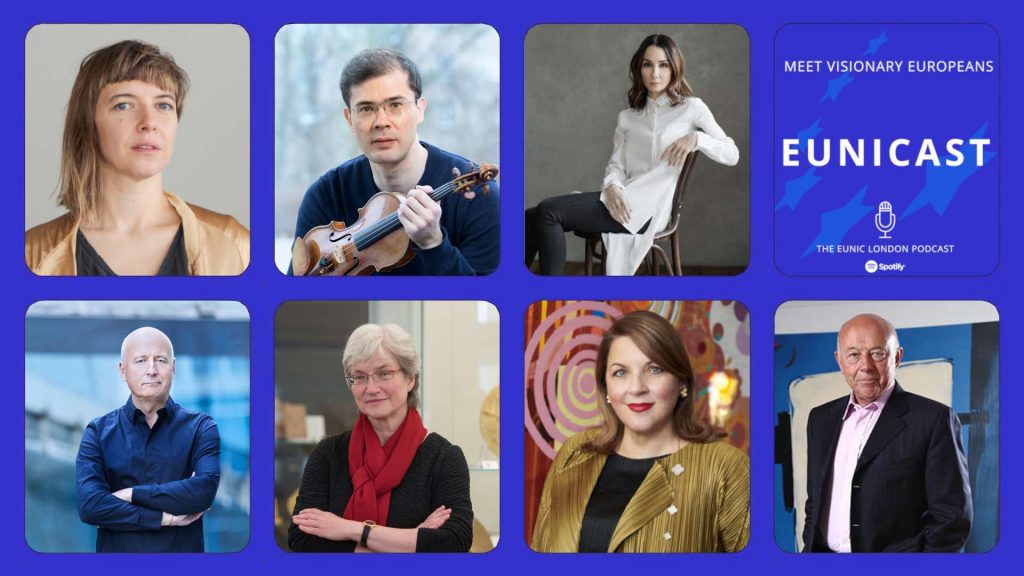BBC journalist Joe Lynam introduces EUNICAST: Meet Visionary Europeans
BBC journalist Joe Lynam introduces EUNICAST: Meet Visionary Europeans, EUNIC London ‘s brand new podcast series featuring some of Europe’s most talented and respected artists, performers & influencers.
Sign up on our Facebook event page:
Tamara Rojo highlights the contribution of Spanish immigration to London
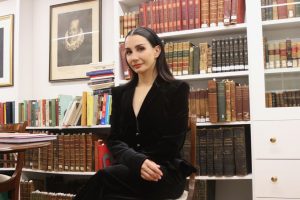
Dancer and director of the English National Ballet, Tamara Rojo, highlighted the contribution of Spanish immigration to London during her participation in a meeting of the new series of White-White Dialogues, in a conversation with the director of the Cervantes Institute in London, Ignacio Peyró.
The prestigious dancer reviewed her extraordinary artistic career and talked about the world of dance, her sacrifices and her successes, as well as the career of a Spanish woman who has triumphed in the British world.
Rojo came to London 22 years ago and remembers that everything was closed on Sundays and at six in the afternoon. But he acknowledges that he has now become a much more cosmopolitan city and part of that has been due to the contribution of Spanish immigration.
“Obviously, for me that is a pleasure. Above all, in gastronomy, because it must be recognised that British gastronomy, 20 years ago, did not have a high quality. The influence that there are so many Spanish restaurants here, so many business circles of Spanish people, artists and people that I can deal with, I think is something very positive,” she added.
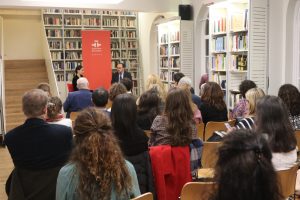
London: cultural capital of the world
For Rojo, London right now is the cultural capital of the world, because it contains a little bit of everything. “That is one of the main reasons why I love living here. As an artist, I love meeting artists and works of all kinds. It is a constant source of inspiration. The only stressful thing about London is that there is not enough time in the year to see everything there is,” explained Rojo.
The dancer recognises that her dreams have evolved. When she arrived here she wanted to be a dancer, then a prima ballerina and finally to perform and work for the The Royal Ballet. Right now, she has been artistic director for the English National Ballet for seven years, and she believes that this year is the completion of her original vision she envisaged when she first took the role. Namely, Rojo has moved the National Ballet to new facilities, being invited by theatres such as the Bolshoi in Moscow or the Paris Opera, with an international reputation, and with the works they have created.
New challenges
“Let’s say that, finally, the company is now what I thought it could be. Obviously, up to a point, now the best comes, the icing. I still have many things to do,” she says. Among those challenges is to reinterpret the classics, not only in a contemporary way, but also with a classical vocabulary, to make the company financially more and more independent and secure: “It’s nothing totally new, but an expansion of our vision, which I feel that only now we have achieved”.
The White-White Dialogues bring great characters related to Spanish culture and relations between Britain and Spain to the British public. In a relaxed and relaxed atmosphere, prone to confidences, Rojo opened this new format with an in-depth conversation, open to the public, in the library of the Cervantes Institute in London.

“We are in a very complicated moment with Brexit. Not only for me personally or for in English National Ballet, but also for all creative industries,” defended the dancer. In the first place, she believes that this will be the case for the creative industries, since both London and the United Kingdom feed on the freedom of movement of individuals and also of materials.
“Many British musicians survive thanks to coming and going to Europe. Also co-productions, festivals, touring Europe without paying different taxes for sets and costumes. The expense, the time, the visas… For us it will be bad, but for companies of less resources and individual artists it can be lethal”, Rojo recognizes.
Relevance of the White-White Dialogues
Peyró highlighted the relevance of these dialogues to deepen the ties that unite both countries, in a cycle that in the coming months will also feature the presence of the writer and Cervantes 2016 award winner Eduardo Mendoza, chef Jose Pizarro and the journalist, writer and businessman Juan Luis Cebrián, among others.
«We want to offer, above all to our Spanish students, access to relevant personalities and with great experience, which, in this environment of confidence, can bring them closer to culture and language,» Peyró said.
Tamara Rojo destaca el aporte de la inmigración española a Londres

La bailarina y directora del English National Ballet, Tamara Rojo, destacó el aporte de la inmigración española a Londres durante su participación en un encuentro de la nueva serie de Diálogos Blanco-White, en una conversación con el director del Instituto Cervantes de Londres, Ignacio Peyró.
La prestigiosa bailarina repasó su extraordinaria trayectoria artística y habló del mundo de la danza, de sus sacrificios y sus éxitos, y de la carrera de una española que ha triunfado en el mundo británico.
Rojo vino a Londres hace ya 22 años y se acuerda de que todo estaba cerrado los domingos y a las seis de la tarde. Pero reconoce que ahora se ha convertido en una ciudad mucho más cosmopolita y parte de eso ha sido por el aporte de la inmigración española.
“Obviamente, para mí eso es un gusto. Sobre todo, en la gastronomía, porque hay que reconocer que la gastronomía británica, hace 20 años, no tenía una gran calidad. La influencia de que haya tantos restaurantes españoles aquí, tantos círculos de negocios de personas españolas, de artistas y gente con la que me puedo tratar, creo que es algo muy positivo”, añadió.

Londres, capital cultural del mundo
Para Rojo, Londres ahora mismo es la capital cultural del mundo, porque en ella puedes encontrarlo todo. “Esa es una de las razones principales por las que me encanta vivir aquí. Como artista, me encanta conocer a artistas y obras de todo tipo. Es una fuente constante de inspiración. Lo único estresante de Londres es que no hay suficiente tiempo en el año para ver todo lo que hay”, explicó Rojo.
La bailarina reconoce que sus sueños han ido evolucionando. Cuando llegó aquí quería ser bailarina, después primera bailarina, después ir al Royal Ballet. Ahora mismo, lleva siete años como directora artística, y cree que este año es, en el que ha llegado a la visión que ella tenía cuando tomó la compañía. Es decir, mudarse a las nuevas instalaciones, ser invitados por teatros como el Bolshoi de Moscú o la Ópera de París, con una reputación internacional, y con las obras que han creado.
Nuevos retos
“Digamos que, finalmente, la compañía es ahora la que yo pensaba que podía ser. Obviamente, hasta cierto punto, ahora llega lo mejor, la guinda, todavía me quedan muchas cosas por hacer”, subrayó. Entre esos retos se encuentra reinterpretar los clásicos no solo de forma contemporánea, pero también con un vocabulario clásico, hacer que la compañía sea financieramente cada vez más independiente y segura: “No es nada totalmente nuevo, pero una expansión de nuestra visión, que siento que solo ahora hemos llegado”.
Los Diálogos Blanco-White acercan al público británico a grandes personajes relacionados con la cultura española y las relaciones entre Gran Bretaña y España. En un ambiente distendido y relajado, propenso a las confidencias, Rojo estrenó este nuevo formato con una conversación en profundidad, abierta al público, en la biblioteca del Instituto Cervantes de Londres.

“Estamos un momento bastante complicado con el Brexit. No solo para mí personalmente o para en English National Ballet, sino también para todas las industrias creativas”, defendió la bailarina. En primer lugar, cree que así lo será para las industrias creativas, pues tanto Londres como el Reino Unido se alimentan de la libertad de movimientos de individuos y también de materias.
“Muchísimos músicos británicos sobreviven gracias a ir y venir a Europa un día, también coproducciones, festivales, giras por Europa sin tener que pagar diferentes impuestos por sets y los trajes. El gasto, el tiempo, los visados… Para nosotros va a ser malo, pero para compañías de menos recursos y artistas individuales puede ser letal”, reconoce.
Relevancia de los Diálogos Blanco-White
Peyró destacó la relevancia de estos diálogos para ahondar en los lazos que unen a ambos países, en un ciclo que en los próximos meses también contará con la presencia del escritor y premio Cervantes 2016 Eduardo Mendoza, el chef Jose Pizarro y el periodista, escritor y empresario Juan Luis Cebrián, entre otros.
“Queremos ofrecer, sobre todo a nuestros alumnos de español, el acceso a personalidades relevantes y con gran trayectoria, que, en este ambiente de confidencia, les puedan acercar a la cultura y el idioma”, señaló Peyró.
Tamara Rojo launches the new White-White Dialogues at Instituto Cervantes in London
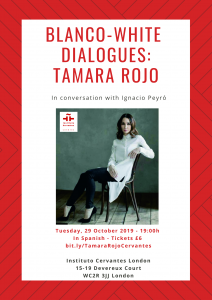
The new series of White-White Dialogues will feature an exceptional guest, the dancer and English National Ballet director, Tamara Rojo, next Tuesday, October 29 at 7:00 pm, in a conversation with director of Instituto Cervantes in London, Ignacio Peyró.
The prestigious dancer will review her incredible artistic career and talk about the world of dance, her sacrifices and her successes, and the career of a Spanish woman who has triumphed in Britain, in an event that will be held in Spanish language.
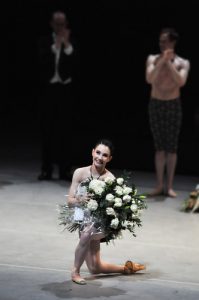
The White-White Dialogues bring great characters related to Spanish culture as well as Anglo-Spanish relations between to the British public. In an informal and relaxed environment, Rojo, opens this new format with an in-depth conversation with the public as though they were her close confidants.
Peyró highlights the relevance of these dialogues to deepen the ties that unite both countries, in a cycle that in the coming months will also feature the presence of writer and 2016 Miguel de Cervantes Literature Prize, Eduardo Mendoza, chef Jose Pizarro and journalist, writer and businessman Juan Luis Cebrián, among others.
“Above all, we want to offer to our Spanish students, access to relevant personalities with great experience, which, in this environment of confidence, can bring them closer to culture and language,” says Peyró.

Box office records
Rojo was named artistic director of the English National Ballet in 2012. She combines this role with her career as a dancer, acting as the company’s principal director. Six months after joining the English National Ballet, Rojo was promoted to director and went on to dance all the main roles of the company. Her performances as Clara in The Nutcracker broke all box office records at the London Coliseum and The Times newspaper named her the «Dance Revelation of the Year.»
Rojo joined the Royal Ballet as director at the invitation of Sir Anthony Dowell shortly after her acclaimed debut as a guest artist in Giselle, by Sir Peter Wright, and danced there for 12 years. Since then, Rojo has been recognized repeatedly for her artistic excellence
The awards she has received include: the Laurence Olivier 2010 Award for Best New Dance Production; the three highest honors in Spain, the Prince of Asturias Award, the Gold Medal of Fine Arts and the Number Entrust of Isabel la Católica. In 2016, Rojo also received the badge that accredits her as Commander of the Order of the British Empire for her contribution to dance.

An homage to Blanco-White
The name of the cycle is a tribute to José María Blanco-White, (Sevilla, 1775 – Liverpool, 1841); writer, theologian, journalist, literary critic, secularised Catholic priest and one of the three great Spanish heterodox converts to nineteenth-century Protestantism, along with Luis de Usoz y Río and Juan Calderón.
In the past, the cycles reminded the Spanish exiles in the United Kingdom, but they also talked about British travelers on the peninsula or about little known episodes of naval history.
Sevillian Blanco-White was characterized by his progressive ideas, by his critical posture towards slavery and social inequality and by his gradual support for the independence of the colonies of Spain in America. More than a century after his death, the writer Juan Goytisolo, Cervantes Prize 2014, once again gave Blanco White a voice by writing extensively about his life and work.
